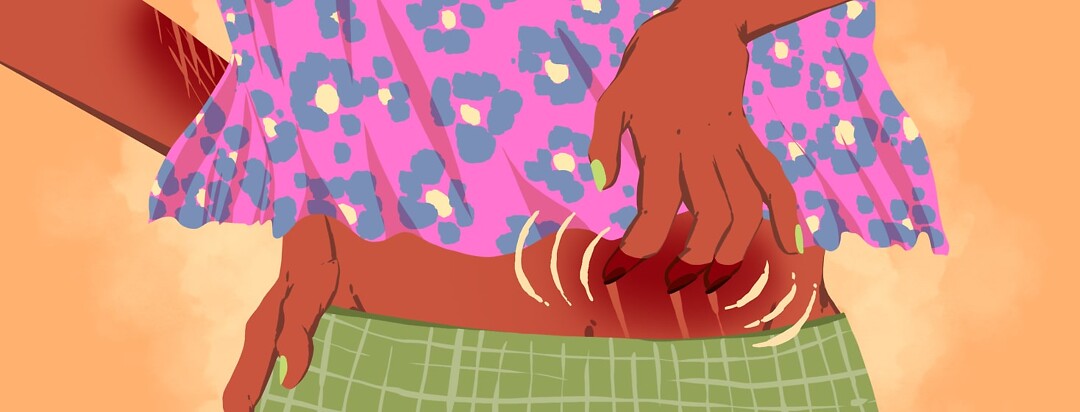Coping With Itchy Skin and RA
I have had dry skin for most of my life but did not know, until several years after being diagnosed with rheumatoid arthritis (RA), that I also had a very common comorbidity of RA known as Sjogren’s syndrome.
"Between 400,000 and 3.1 million adults have Sjogren’s syndrome. This condition can affect people of any age, but symptoms usually appear between the ages of 45 and 55. It affects ten times as many women as men. About half of patients also have rheumatoid arthritis or other connective tissue diseases, such as lupus."1
What is xerosis?
Among the many symptoms of Sjogren’s that include dry eyes, dry mouth, and dry sinuses, the one I want to address is dry skin, also known as xerosis, or clinically dry skin.2
Although I have been successful in treating the other symptoms, dry skin has been my nemesis and, of late, has begun to disrupt my sleep thanks to the presence of itching. I don’t just mean an occasional itch on my arm, but rather a constant, never-ending, persistent need to scratch my arms, back, abdomen, etc.
It is important to note that I do not have any rash, which can accompany Sjogren’s. My skin has a very dry, almost leathery appearance that is sadly not relieved by the far too many moisturizers I have in my cupboard.
Issues with dry skin have intensified
I have suffered from this over the years off and on, but lately, it has become so intense that it is not only interrupting my sleep but causing me to be sleep-deprived. Several nights I have had less than 3 hours of sleep total.
The only relief I get is to get up and walk around, as being up and moving rather than having the pressure of the bed, sheets, pajamas against my skin, seems to stem the itching. That is until I lay back down and the cycle starts all over again. I feel like I have a constant case of poison ivy!
6 tips for dry skin and nocturnal itching
Nocturnal itching (pruritus) as it relates to Sjogren’s is very challenging to treat. But, I have found a few things, including some major changes to how I care for my skin, that seem to be helping a bit so I will offer them here to those who may have this same issue. These are recommendations from dermatologists, various Sjogren’s websites, and my own rheumatologist.
Water temperature and showering frequency
How I shower needed a big update. I love very hot, long showers or baths as they offer great joint relief when I am having an RA flare. Even just soaking in a hot tub or jacuzzi was delightful and my joints loved it! Well, not my skin as it turns out. Now I know that I need to take short, lukewarm to cool showers and to not do that more than once a day if that often.
Use unscented soap
Additionally, I now use sensitive skin (not scented) soap or body wash and I apply it gently with my hands or a soft cloth. For drying, I now pat dry or air dry my body. In the past, I used to luffa my skin and dry it briskly with a towel. No more.
Use creams with ceramides
After drying, I apply a cream that has ceramides which are moisture retaining barriers for our skin. What I like about them is that they are not heavy or greasy like some others that I found just lay on my skin and make the itching worse. There are many creams on the market that contain ceramides and your doctor can suggest what creams or lotions would best suit your skin situation.
Another suggestion that worked for me was to keep an itch relieving cream in the fridge and when it gets really crazy, lightly apply it. Also, I wear very roomy (think two sizes too big) pajamas and sleep on cool retaining sheets.
Antihistamines and dietary changes
My physician also suggested taking an antihistamine now and then if it gets really unbearable. Sometimes, that is the only way I get any sleep. That said, only do so with the approval of your doctor.
There are also dietary suggestions that have helped some folks.
Talk to your doctor
Consulting your dermatologist, rheumatologist, and/or primary care physician in order to fully address the itchy skin situation that many of us face is the best first step in getting the relief that we all need.
I am seeing some improvement in this latest Sjogren’s flare after following the suggestions I outlined above and hopefully these tips will prove useful to others who have found it challenging to live with the skin conditions associated with Sjogren’s.
Nan

Join the conversation